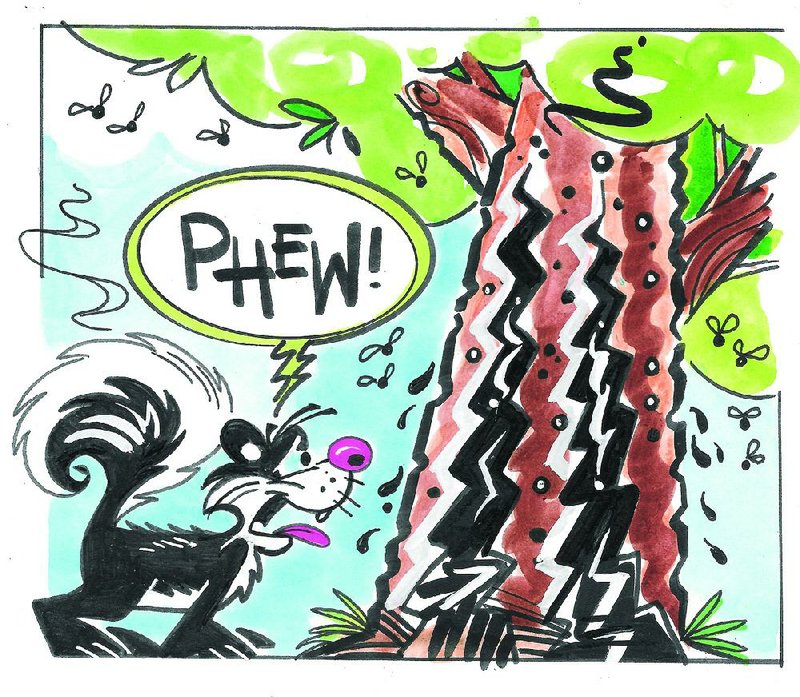Q My Knockout roses, which I cut back in February to 1 foot, are now about 5 feet tall plus they are hindering a street view. Can I take them down a foot now without damage to them?
A By all means make sure you have good visibility to the street. Many rose growers do a light haircut in late summer to give their roses a break from the heat, and then the plants bounce back with better blooms in the fall.
Q I have a very large water oak tree (which is 27 years old) that has black streaks running down the trunk. I was told it was worms and to put Vaseline in the holes, which I did. Doesn't seem to be helping. I am afraid it is being eaten from inside and I will lose the tree if it is not properly addressed.
A Without seeing the tree, my guess would be wetwood, also called slime flux. It is caused by a buildup of gas within the tree. When we have a downpour after a dry period, we commonly see a substance coming out of holes or cracks in affected trees. The substance can be dark or white and frothy, but it usually has a sour smell and can attract insects. Usually little damage is done to the tree, but you can use a hose to wash it off the trunk. We used to recommend drilling holes underneath where it was coming out to release the pressure and then putting a pipe in to drain the liquid away from the trunk. Research has shown that this practice is not necessary since trees showed no difference in recovery with or without the extra holes, which were also adding wounds to the tree.
Q We live in Fayetteville. We have beautiful foliage on our hydrangea plants, but here we are in late July and thus far no blooms. They have bloomed profusely in other years. What are -- or aren't -- we doing?
A Where did the foliage begin growing this spring? Traditional big leaf hydrangeas bloom on old wood, setting blooms in the fall before they go dormant. If the plants are killed back to the soil line during a cold winter, they won't bloom the next spring. Many new varieties (which started with "Endless Summer") bloom on the old wood and the new wood, so we can still have flowers regardless of winter. I think the reblooming types are needed in the northern tier of the state. Or you could switch over to panicle hydrangeas, which bloom on their new growth. Their flowers are white with some varieties having a pink tint. They will bloom regardless of the winter.
Q We just moved and have a wonderful and challenging backyard. Are you aware of any landscape designers that design drought- and deer-resistant landscapes? It isn't sprinkled, is in the broiling sun all day, and we have lots of deer friends.
A We have some reference material on our University of Arkansas Cooperative Extension Service website that can help with deer. We have a list of deer-resistant plants at uaex.edu; search for "Deer resistant plants." Search for "Dealing with pesky deer" to pull up another fact sheet. As to landscape designers with these plants in mind, I am sure you can ask any designer. Water, however, will be necessary even for drought-tolerant plants to get them established, and now would not be a good time to get started. Fall would be ideal, as we typically have more moisture then to help the plants' root systems get established.
Q Across the back edge of my yard is a drainage ditch. There are 14 trees, mostly pines, on the 130 feet of my yard along the bank. What would be a good shade-loving ground cover to help prevent erosion? Something not super aggressive that I can control with a mower and that won't overgrow the trees?
A There are several "grassy-like" plants that would work, including one of the acorus (sweet flag) or carex (sedge) plants. There are several options to choose from with green foliage or variegated and even yellow foliage. You could also use mondo grass or monkey grass. If you want a vining plant that is not overly aggressive, you could use Asiatic jasmine.
Janet B. Carson is a horticulture specialist for the University of Arkansas Cooperative Extension Service. Write to her at 2301 S. University Ave., Little Rock, Ark. 72204 or email her at
HomeStyle on 08/04/2018

